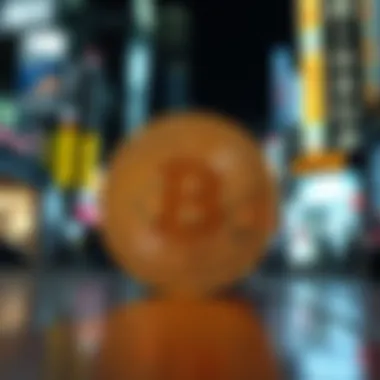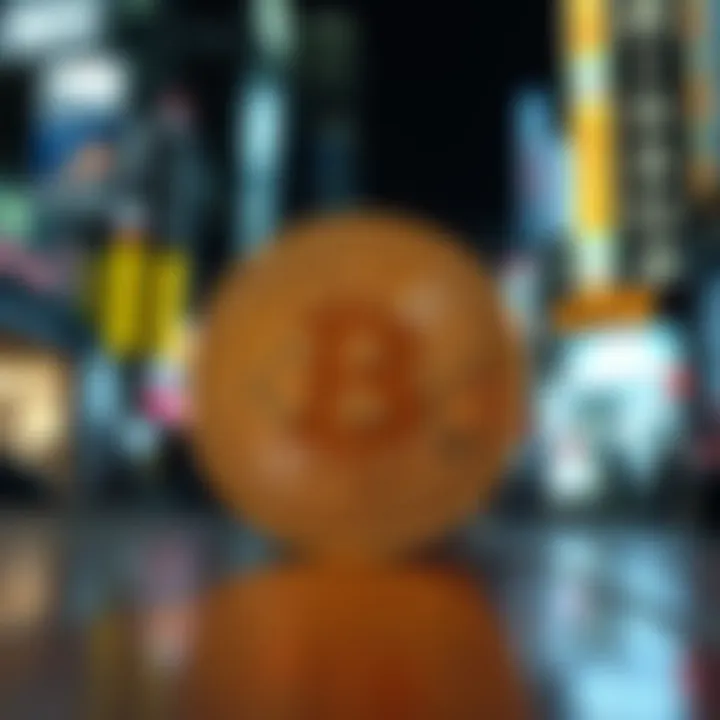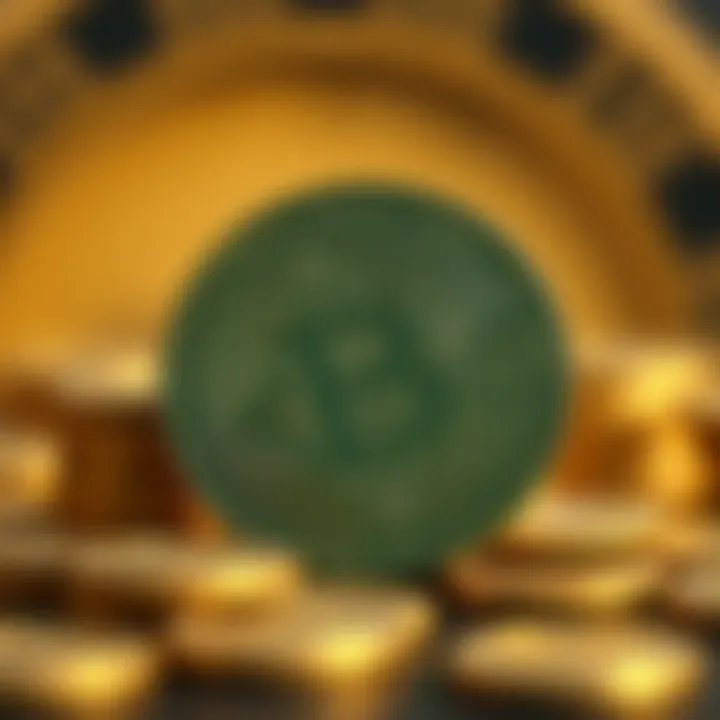Tokenizing NFTs: Exploring New Avenues in Digital Assets


Intro
In recent years, the emergence of non-fungible tokens, or NFTs, has captured the attention of various sectors, from art to gaming and even real estate. This newfound digital asset class leverages the power of blockchain technology to enable unique ownership of asset representation. Tokenization, the process of converting physical or digital assets into a digital token, adds another layer of complexity and opportunity within this realm. It’s not just a fad; it’s a shift in how we view ownership, transactions, and the very essence of value itself.
As the discussion around NFTs continues to unfold, understanding the underlying mechanisms of tokenization becomes crucial for investors, traders, and tech enthusiasts alike. This article ventures into the intricate landscape of tokenizing NFTs, unpacking its implications, the challenges it presents, and how it interweaves with broader cryptocurrency dynamics.
Cryptocurrency Fundamentals
Understanding Blockchain Technology
At the heart of NFTs lies blockchain technology—a decentralized and distributed digital ledger that records transactions across multiple computers. The principle of immutability ensures that once data is written into the blockchain, it cannot be altered. This secures the authenticity and ownership of NFTs. Think of blockchain as an unbreakable chain, where each link is a record of a transaction, contributing to the full narrative of an asset.
The most widely used blockchain for NFTs is Ethereum, given its robust support for smart contracts. Smart contracts are self-executing contracts with the terms of the agreement directly written into code. This programmability allows creators to set specific conditions for the sale and transfer of their NFTs, adding complexity and security to transactions.
Key Concepts in Cryptocurrency Trading
Understanding the basics of cryptocurrency trading can aid those venturing into NFTs. Key concepts include:
- Exchange Platforms: Sites like Coinbase and Binance where cryptocurrencies are bought and sold.
- Market Orders and Limit Orders: Market orders buy immediately at current prices, while limit orders buy based on set prices.
- Volatility: The unpredictability of cryptocurrency prices, which can affect NFT values dramatically.
Familiarity with these aspects of trading will prove essential for navigating the transient landscape of NFTs, as the value of tokens can fluctuate wildly based on market sentiment and demand.
Market Insights
Current Trends in the Crypto Market
As of now, the crypto market is witnessing a surge in interest around NFTs. There's been a growing trend towards tokenizing not just art and collectibles but also real estate, music, and virtual goods. This diversification is reshaping perceptions of ownership and investment. Digital ownership is becoming as legitimate as traditional ownership, as evidenced by the multi-million dollar sales of NFT artworks, like Beeple's "Everydays: The First 5000 Days."
Analyzing Market Movements and Predictions
Understanding market movements can provide crucial insights into future trends. The NFT sector is characterized by rapid changes influenced by social media, celebrity endorsements, and technological advancements. For instance, a tweet or an announcement can send prices soaring. It is vital for market participants to remain vigilant and be ready to adapt to these changes.
As we look to the future, the implications of tokenizing NFTs could extend beyond mere ownership, affecting how we think about investment, valuation, and even copyrights in the digital era.
"Tokenization of assets could potentially democratize access to investment opportunities, allowing more people to partake in markets that were previously out of reach."
For further reading, refer to resources like Wikipedia on Blockchain Technology, or explore articles on Investopedia.
Prelude to Tokenization and NFTs
The ability to tokenize assets reshapes how we perceive ownership, especially in our increasingly digital world. Understanding tokenization, particularly when applied to non-fungible tokens (NFTs), opens avenues for innovation in various sectors. As we dive into the intricacies of tokenization, clarity around its mechanics and significance becomes essential.
Defining Tokenization
Tokenization refers to the process of converting ownership rights of a tangible or intangible asset into a digital token on a blockchain. When an asset is tokenized, it creates a digital representation, ensuring that the ownership, provenance, and transferability are recorded securely on the blockchain. This digital asset can be traded, sold, or exchanged, all while preserving its unique identity.
For example, consider the tokenization of a piece of artwork. By creating a digital token that represents the artwork, the artist can sell partial ownership to multiple buyers, allowing for a broader audience to engage with and invest in the piece. Such a shift also caters to liquidity, enabling assets that were previously illiquid to be transacted with greater ease.
Overview of Non-Fungible Tokens
Non-fungible tokens are a specific type of digital asset that represent ownership of unique items. Unlike cryptocurrencies like Bitcoin or Ethereum, which are fungible and can be exchanged for one another, NFTs hold distinct information and value. This uniqueness can pertain to digital art, music, virtual real estate, or any digital collectible.
The advent of NFTs has enabled artists and creators to retain control over their digital work. By utilizing platforms such as OpenSea or Rarible, they can tokenize their creations directly without intermediaries. Over time, the NFT marketplace has grown exponentially, leading to significant revenues for creators while fostering a sense of community among collectors and enthusiasts.
The Intersection of Tokenization and NFTs
Tokenization and NFTs are intertwined concepts that are reshaping the landscape of digital ownership. When one looks closely at the relationship, it becomes evident that NFTs are essentially the embodiment of tokenization in the digital realm. They offer a practical application of tokenization that extends far beyond mere collectibles.
As the realms of technology and finance converge, investors and traders find themselves heavily involved in NFT markets. They recognize that beyond art, tokenized assets may extend to real estate, gaming items, and intellectual property, all of which can be adequately represented through NFTs. The potential for diversification within portfolios can be alluring, as traditional classifications of ownership expand to include these digital assets.
To conclude, comprehensively understanding tokenization and NFTs allows investors, traders, and tech enthusiasts to fully grasp the evolution of digital ownership and asset management in today's rapidly changing economic landscape.


The Mechanics of Tokenization
Understanding how tokenization works is pivotal in grasping the frame through which NFTs operate. Tokenization is not merely a digital transformation of assets; it is a radical shift in how ownership, access, and authenticity are perceived in the digital realm. By dissecting the mechanics behind tokenization, we can better appreciate its manifold benefits, potential hurdles, and real-world applications.
How Tokenization Works
At its core, tokenization transfigures real-world or digital assets into a virtual format, acting as a digital representation on a blockchain. This process involves assigning unique identifiers to each asset, transforming it into tokens—think of it as breaking down a whole loaf of bread into neatly sliced pieces. This tokenization allows for greater accessibility and liquidity since tokens can be traded or sold without the need for traditional intermediaries.
By utilizing various blockchain networks, each token retains its distinct identity, providing proof of ownership and transfer history. The elements of immutability and security provided by blockchain create an atmosphere where buyers and sellers can operate with a degree of trust previously unavailable. It's as if every transaction comes with a notarized seal—ensuring authenticity and legitimacy.
In practical terms, if a digital artist wishes to sell their artwork as an NFT, they can tokenize the piece by creating a unique identifier on the blockchain. This token then holds value and can be bought, sold, or traded.
Utilizing Blockchain Technology
The bedrock of tokenization's effectiveness lies in blockchain technology. It establishes a decentralized ledger, enabling participants to interact in a secure environment without the need for gatekeepers. This setup fundamentally alters the dynamics of asset ownership and exchange. Blockchain's public nature allows anyone to view transaction histories, ensuring transparency in ownership. Each token is anchored in a blockchain, with all pertinent transactional data recorded in a manner that is resistant to alteration.
The advantages of using blockchain technology are manifold:
- Decentralization: Eliminates the monopoly of centralized entities, putting the power back into the hands of the individuals.
- Transparency: All transactions are visible on the public ledger, enabling validation before the exchange occurs.
- Security: The cryptographic nature of blockchain technology helps safeguard against fraud and theft.
Every time a token is transferred, the blockchain updates the ownership records without deviation. This ensures the integrity of the token, building a reliable marketplace where digital ownership thrives.
Smart Contracts in Tokenization
Smart contracts serve as the backbone of many tokenization processes. They are self-executing contracts with the terms directly written into code, allowing for automatic enforcement of agreements once pre-defined conditions are met. This eliminates the need for third-party intervention, streamlining transactions and minimizing potential disputes.
Here’s why smart contracts are indispensable in tokenization:
- Automation: Transactions can occur in a flash without human input, reducing delays and operational costs.
- Trust: The code’s execution is based on pre-set conditions, establishing a trustless environment where parties can engage without fear.
- Flexibility: Smart contracts can be tailored to meet an array of requirements, making them suitable for various applications beyond NFTs.
For instance, if an artist set a condition in their smart contract that states a particular percentage of resale profits must go back to them, the system self-enforces this rule each time their artwork is resold. This mechanism not only benefits the artist but also reinforces the importance of intellectual property rights within the NFT realm.
"Tokenization elevates the concept of ownership, allowing individuals to own fractional pieces of assets that previously remained locked behind hefty price tags."
In summary, understanding the mechanics of tokenization involves appreciating the crucial role that blockchain technology and smart contracts play in redefining asset ownership. As we move toward an increasingly digitized world, these mechanics will guide the evolution of markets focused on non-fungible tokens.
Types of Token Standards
When discussing the world of NFTs, the concept of token standards assumes a pivotal role. It forms the backbone for how digital assets are created, managed, and traded. Understanding these standards is essential for anyone engaged in the NFT space, whether as an investor, creator, or tech enthusiast. Different token standards offer unique features and functional capabilities, shaping the manner in which ownership, value, and utility are realized across platforms.
Exploring token standards not only sheds light on their technical specifications but also adds insight into how they affect market dynamics, interoperability, and user experience. Proper utilization of these standards can unlock new potential in the world of tokenized assets, thereby enhancing both transactional efficiency and buyer security. Each token standard essentially provides a language through which creators, platforms, and consumers communicate with one another in the digital realm.
ERC-721: The Pioneer of NFTs
ERC-721 is often heralded as the standard that started the NFT revolution. It governs the creation of non-fungible tokens that are distinctly unique. Unlike fungible tokens, such as cryptocurrencies, where every unit is interchangeable, each ERC-721 token has unique attributes or metadata that distinguish it from others in its class. This characteristic is the cornerstone for digital art and collectibles, making it particularly popular for creators aiming to assert ownership and provenance of their works.
The arrival of ERC-721 came with its share of challenges. Initially, it faced issues regarding interoperability; many platforms struggled to support it effectively. However, its significance cannot be overstated. Now, ERC-721 tokens are widely accepted across major NFT marketplaces, providing a robust framework for digital assets. In essence, this standard allows artists and collectors to interact in a way that traditional markets cannot facilitate, granting them freedom over their creations and investments.
ERC-1155: Advancements in Tokenization
In contrast to its predecessor, ERC-1155 introduces a multi-token standard that permits the management of multiple token types within a single contract. This might sound trivial, but it streamlines processes and significantly reduces transaction costs. Imagine being able to handle fungible tokens and various non-fungible tokens concurrently, all under a single umbrella. This provides artists and platforms with incredible flexibility, particularly in gaming and virtual goods contexts, where multiple asset types might coexist.
Another intriguing aspect of ERC-1155 is its capability to allow batch transfers of tokens. This means users can transfer multiple NFT types in a single transaction, saving time and resources. For creators and gamers alike, this standard enhances the overall experience of owning and trading assets in a more intuitive and cost-effective manner. It's no wonder that ERC-1155 is gaining traction among developers, shaping a more efficient digital landscape.
Comparative Analysis of Standards
When one compares ERC-721 and ERC-1155, it's clear that each serves distinct needs. The former excels in providing singular unique tokens, ideal for creating exclusive pieces such as rare collectibles or unique artworks, while the latter shines in versatility.
This comparison can be summarized in the following points:
- Fungibility: ERC-721 is strictly non-fungible, whereas ERC-1155 can handle both fungible and non-fungible tokens.
- Efficiency: ERC-1155 offers cost advantages through batch processing and reduced transaction fees, making it favorable in high-volume environments.
- Complexity: ERC-721 is generally simpler and is easier for newcomers to grasp when initiating their journey into NFTs. On the other hand, ERC-1155's learning curve might be steeper, but it ultimately provides a richer toolkit for developers.
Benefits of Tokenizing NFTs


The process of tokenizing NFTs translates into a plethora of advantages that reshape how ownership and value transfer are perceived. In the evolving digital landscape, these benefits serve as critical pillars that prop up the architecture of tokenization, enabling both creators and collectors to navigate the market with newfound confidence. Here’s a closer look at the notable benefits:
Enhanced Ownership Control
When an NFT is tokenized, the essence of ownership extends beyond mere possession. Tokenization grants individuals robust control over their digital assets. With blockchain technology underpinning this process, ownership is traced immutably, making it practically impossible to forge or falsify ownership records. This denotation helps to eliminate issues surrounding provenance—, an aspect particularly significant in art and collectibles.
Furthermore, the incorporation of smart contracts allows owners to set conditions on how their NFTs can be used or transferred. For example, a musician could create a tokenized album, giving fans access only upon specific conditions being met, or earn royalties every time the NFT changes hands. This intricate level of control is just a fraction of what tokenization offers, as it preserves the rights of the creators while rewarding them proportionally to their contributions.
Accessibility and Liquidity
Tokenizing NFTs also fosters unparalleled accessibility, inviting a more extensive range of participants into the marketplace. Unlike traditional art galleries or collectibles exhibitions that may impose steep entry barriers, online platforms allow potential buyers to explore a diverse array of digital items from the comfort of their homes. This democratization invites artists from all corners of the globe to showcase their work, bridging gaps between creators and consumers who might not have crossed paths otherwise.
Moreover, tokenization enhances liquidity— a crucial element for investors. Unlike physical assets that might take ages to sell, NFTs offer potential buyers the opportunity to buy and sell instantly on various marketplaces. The ability to rapidly liquidate an asset has transformed how individuals manage their portfolios while contributing to vibrant, active market conditions.
Global Market Reach
One of the most transformative aspects of NFT tokenization lies in its global market reach. In a traditional sense, local markets often dictate the value of tangible assets, but tokenization circumvents this limitation. As NFTs can be traded across borders without the constraints of conventional financial systems, a piece of digital art from a niche creator in one country can attract interest from collectors in another continent. This global connectivity fosters a more dynamic price mechanism determined by supply and demand rather than locality.
The implications are profound. It opens the floodgates for cross-cultural exchanges, enabling innovations in branding, collaborations, and the mixing of industries. For instance, a gamer in Japan might find the perfect digital collectible from an artist in Italy, thereby enriching the experiences for both parties involved. The global reach of tokenization is weaving together a community where value knows no geographical boundaries.
Challenges in Tokenizing NFTs
The rapid rise of NFTs and the process of their tokenization has garnered significant attention. Despite the myriad of benefits associated with this technology, it comes with its unique sets of challenges. Understanding these hurdles is crucial for anyone interested in this new frontier of digital asset management. These challenges not only impact the market dynamics but also shape the future of NFT tokenization itself. Let's dive into the specific issues that creators, investors, and marketplaces face.
Legal and Regulatory Hurdles
One of the most daunting challenges in tokenizing NFTs is navigating the legal and regulatory landscape. The laws governing digital assets are still in a state of flux, varying dramatically from one jurisdiction to another. For instance, consider artists who tokenized their artwork. In some regions, they face copyright complications while minting NFTs, as existing laws might not fully cover the intricacies of digital ownership. This can lead to potential lawsuits and undermine the very essence of what NFTs promise - security and protection for creators.
"It's like walking through a legal maze; each turn could mean deeper complications."
Moreover, the classification of NFTs can also be problematic. Are they assets, securities, or collectibles? This ambiguity complicates regulatory compliance. Platforms must keep an eye on pending legislation to avoid future risks, ensuring they comply with laws like the SEC in the U.S. or the FCA in the U.K. Thus, the legal framework remains a significant barrier, demanding attention from both regulatory bodies and market participants alike.
Market Saturation and Value Fluctuation
Another considerable concern lies in market saturation and the consequent fluctuation in value. As more creators and projects dash into the NFT space, the market could potentially become overpopulated. There are thousands of tokens available, from digital art to music and everything in between. While diversity in offerings is good, it can dilute value.
Investors need to be wary of volatility. For example, during the peak of the NFT boom, certain pieces sold for astronomical prices, only to plummet shortly after. This wild fluctuation fosters skepticism among potential investors, making it hard for serious projects to establish stable pricing models. To navigate this landscape effectively, both buyers and sellers must adopt sophisticated strategies, considering factors such as rarity, demand, and overall market sentiment.
Technical Barriers to Entry
Technical barriers also contribute to the complexities of tokenization. While blockchain technology itself has made creating NFTs more accessible than ever, there remain significant hurdles in terms of user experience. Many newer users find the process somewhat daunting, laden with jargon and niche understanding. For example, understanding how to install digital wallets or interact with blockchain networks can be a significant obstacle for those who might be new to this technology.
This complexity often leads to hesitation among potential creators looking to enter the NFT space. It isn’t just about minting a token; it’s ensuring that the entire process is securely handled. Issues such as wallet security, gas fees, and transaction speeds further add layers to the confusion. Users are not only required to grasp the technical aspects but must also navigate the scattered resources available—many of which may not be user-friendly.
The Role of Marketplaces in NFT Tokenization
The landscape of NFT tokenization cannot be fully understood without examining the critical role marketplaces play in this ecosystem. These platforms serve as the bridges where creators, collectors, and investors converge to exchange digital assets. Understanding their function goes beyond mere transactions; it involves recognizing how they influence accessibility, security, and the overall success of NFTs. Therefore, this section aims to dissect the significance of marketplaces in the tokenization of NFTs while emphasizing various related aspects.
Leading Marketplace Platforms
Several platforms have risen to prominence in the NFT space, each with its own unique features and target audience. Here are some of the leading marketplace platforms today:
- OpenSea: Often considered the Amazon of NFTs, OpenSea provides a vast array of digital assets ranging from art to virtual real estate. This platform stands out due to its user-friendly interface and an extensive selection of NFTs.
- Rarible: This community-driven platform enables users not only to buy and sell NFTs but also to create and issue their own. Rarible’s governance token, RARI, empowers users with decision-making capabilities within the platform.
- Foundation: Known for its curated approach, Foundation is an invite-only marketplace focusing on high-quality art. Artists can set their prices, and the limited access helps to establish a more exclusive environment for collectors.
- Nifty Gateway: Partnering with well-known brands and creators, Nifty Gateway prides itself on hosting
Real-World Applications of Tokenization
Tokenization, particularly in the context of non-fungible tokens (NFTs), has made quite a splash in various sectors. Its significance can't be overstated, as it not only revolutionizes how we perceive ownership but also has practical implications that extend far beyond mere digital collectibles. This section will delve into specific domains where tokenization is taking root, highlighting the advantages and nuances of each application.
Art and Collectibles
The art world has always had its quirks, but tokenization brings a fresh spin. By creating a digital certificate linked to a piece of art, artists can maintain provenance and ownership history, which is crucial in a market often riddled with fakes. The use of NFTs as digital collectibles enhances this aspect. For an artist, every time their work is sold, they can earn a royalty, ensuring continued income as the piece changes hands. Beyond the traditional galleries, platforms like Artsy and OpenSea are enabling more artists to enter the market without relying on middlemen.
Moreover, collectors appreciate the liquidity provided by tokenization. Unlike keeping a piece of art solely in a gallery or a private collection, NFTs allow owners to buy and sell art online. This accessibility is noteworthy because it democratizes art ownership. Fellow art enthusiasts can invest in pieces they admire without needing an extensive budget, changing what has long been a very closed-off market.


"Tokenization in art not only protects the integrity of the piece but also expands the reach and interaction artists can have with their audiences."
Gaming and Virtual Goods
As gaming continues to evolve, tokens are carving out their niche. The traditional model of owning in-game items has typically favored developers, who can decide when to monetize or retire features. However, the advent of tokenization has altered this dynamic entirely. Players can now own unique items, skins, or characters as NFTs, providing both value and tradeability.
One example is the game Cryptokitties, where players buy, sell, and breed virtual cats, each represented by a unique token. This gameplay dynamic not only adds an element of investment but also strengthens community engagement. By facilitating a marketplace for these virtual goods, developers can retain players longer by acknowledging that their in-game assets have real-world value outside the game.
Furthermore, the gaming industry is witnessing the rise of play-to-earn models, allowing players to generate income while enjoying their favorite games. This concept elevates gaming from simple entertainment to an avenue of economic opportunity, reflecting the shift in how players interact with the digital landscape.
Intellectual Property and Branding
Tokenization also extends its reach into the realm of intellectual property (IP) and branding. It's becoming increasingly important for creators and businesses to establish ownership and control over their digital assets. By tokenizing IP, individuals and companies can safeguard their creations against unauthorized use, providing a transparent ledger of ownership.
For instance, musicians can tokenize their songs. By doing so, they can offer fans a stake in their future earnings—an innovative way to fund new projects. This not only builds a more engaged fan base but also enables artists to bypass traditional record label constraints. Similarly, brands are starting to explore tokenized merchandise. Imagine a sneaker brand releasing limited-edition shoes as NFTs, where each token signifies ownership of a physical pair, blending the virtual and tangible worlds seamlessly.
In summary, the real-world applications of tokenization are a testament to its versatility. From enhancing the way we think about art and gaming to providing new avenues for protecting intellectual property, the potential remains immense. As these applications continue to expand, they will pave the way for a future where digital ownership is not just a buzzword but a foundational aspect of our economy.
Future Trends in NFT Tokenization
The landscape of NFT tokenization is evolving rapidly. The significance of this topic lies in the sheer potential it holds for reshaping digital ownership, enhancing interactions between creators and consumers, and establishing new revenue streams. As we look to the future, various elements play a crucial role in the direction of NFT tokenization, including emerging technologies, market dynamics, and user experience developments. This section will shed light on these trends and offer insights on their implications.
Emerging Technologies Impacting Tokenization
Technological advancements are at the heart of NFT tokenization's future. Several innovations are coming into play:
- Layer 2 Solutions: These aim to alleviate the congestion and high fees often associated with Ethereum. Projects like Polygon and Optimism help facilitate faster transactions while maintaining a connection to the Ethereum blockchain.
- Interoperability Protocols: These promote seamless interactions between different blockchains. Projects such as Polkadot are paving the way for NFTs to traverse multiple ecosystems, essentially polarizing the marketplace by allowing collectors to interact with assets across various platforms.
- Artificial Intelligence and Machine Learning: These technologies can enhance the creation of NFTs by generating unique designs or facilitating smarter pricing strategies based on real-time data analytics of market preferences.
"The future of NFT tokenization lies in harnessing technologies that can drive innovation while making digital assets more accessible to a broader audience."
Market Predictions and Insights
As we delve into market predictions regarding NFT tokenization, certain patterns emerge. With strong demand projected to persist, analysts expect:
- Mainstream Adoption: As platforms simplify the creation and trading processes, the general public is likely to embrace NFTs for art, music, virtual real estate, and more.
- Increased Valuation of Utility NFTs: NFTs that offer tangible benefits, such as access to exclusive events or membership rights, are likely to increase in value as users seek more than just digital ownership.
- Decentralized Autonomous Organizations (DAOs): They may begin to take center stage in deciding the future of NFT projects with a community-driven approach to asset management and governance.
Investors and traders should keep an eye on these trends, as understanding market dynamics can inform better strategic decisions.
The Evolution of User Experience in NFT Markets
User experience is paramount in making NFT markets approachable and engaging. Significant enhancements can be expected in the coming years through:
- Simplified User Interfaces: Platforms are recognizing that ease of use is key. The development of intuitive interfaces can attract non-technical users, making it easier for them to create, buy, or sell NFTs.
- Mobile Accessibility: With the growing reliance on mobile technologies, NFT marketplaces are likely to optimize their platforms for mobile devices, increasing accessibility for users on the go.
- Gamification: Introducing game elements, like rewards for participation, could entice more users to immerse themselves in NFT marketplaces. Expect to see features like achievement badges or leaderboard rankings.
In summary, future trends in NFT tokenization promise to redefine the way digital assets are created, traded, and utilized. By being attuned to emerging technologies, market insights, and user experience enhancements, investors and participants in the NFT space will be better positioned to navigate this dynamic landscape.
Culmination
In wrapping up the discussion around the tokenization of NFTs, it's essential to highlight the various elements that make this topic not just relevant but also crucial in today's digital landscape. The evolving nature of digital ownership, powered by blockchain technology, offers a robust framework where unique digital assets can gain verifiable provenance and authenticity. This shift is particularly significant for creators, investors, and collectors who seek security and transparency in their transactions.
Summarizing Key Insights
Throughout this article, we've explored the multi-faceted nature of tokenizing NFTs. The ability to convert digital assets into tokens comes with a host of advantages:
- Enhanced Control Over Ownership: Tokenization empowers creators and owners with a clear, accessible way to transfer ownership and retain royalties far into the future.
- Increased Market Liquidity: The fractionalization of assets allows investors to partake in ownership without the burden of full asset price payments. This democratizes the market, broadening participation from diverse economic backgrounds.
- Global Reach: Blockchain operates 24/7, enabling transactions across borders without the usual bureaucratic hurdles. This inherent accessibility extends the reach of artists and creators, fostering a more inclusive global market.
Moreover, we have not shied away from discussing the challenges. Legal ambiguities, market saturation, and technical barriers remain hurdles that enthusiasts must navigate. However, the promise of a more equitable digital marketplace where ownership is respected and valued makes this domain worth exploring further.
"Tokenization is not just a trend; it's a paradigm shift in how we perceive and handle digital assets."
The Path Forward for NFT Tokenization
Looking ahead, the future of NFT tokenization is poised to blend creativity with innovation. As we’ve seen during various discussions, emerging technologies such as AI and machine learning are likely to play a pivotal role in refining user experiences and enhancing security protocols.
Furthermore, the regulatory landscape keeps evolving. A clearer regulatory framework can potentially foster user confidence, opening up opportunities for institutional investors who have previously remained on the sidelines. Gig economy participants, artists, and brands must adapt to these changes, leveraging tokenization trends to secure their stakes in this new digital economy.
The continuous evolution of marketplaces, some driven by community needs, others by technological advancements, offers a fertile ground for experimenting and refining NFT applications. As these platforms evolve, user experience will be paramount in drawing more diverse groups into the fold.
In summary, the journey of NFT tokenization presents a myriad of opportunities alongside sizable challenges. By staying informed and adaptable, stakeholders can secure their positions in this burgeoning market and contribute to shaping the future of digital ownership.



